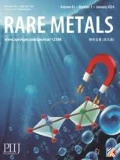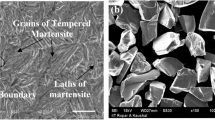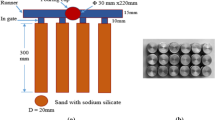Abstract
In order to predict the wearing of stellite alloys, the related methods of rare metals data processing were discussed. The method of opposite degree (OD) algorithm was put forward to predict the wearing of stellite alloys. OD algorithm is based on prior numerical data, posterior numerical data and the opposite degree between numerical forecast data. To compare the performance of predicted results based on different algorithms, the back propagation (BP) and radial basis function (RBF) neural network methods were introduced. Predicted results show that the relative error of OD algorithm is smaller than those of BP and RBF neural network methods. OD algorithm is an effective method to predict the wearing of stellite alloys and it can be applied in practice.

Similar content being viewed by others
References
Yu G, Lu Y, Sheng XF, Jiang YC. Overlaying welding layer and matrix analysis and detection of stellite shell lead off. Power Energy. 2014;35(2):110.
Farnia A, MalekGhaini F, Rao JC, Ocelík V, De Hossonb, J Th M. Effect of Ta on the microstructure and hardness of stellite 6 coating deposited by low power pulse laser treatments. Surf Coat Technol. 2012;213:278.
Luo F, Cockburn A, Lupoi R, Sparkes M, O’Neill W. Performance comparison of stellite 6® deposited on steel using supersonic laser deposition and laser cladding. Surf Coat Technol. 2012;212:119.
Romo SA, Santa JF, Giraldo JE, Toro A. Cavitation and high-velocity slurry erosion resistance of welded stellite 6 alloy. Tribol Int. 2012;47:16.
Chen CJ, Wang MC, Wang DS, Fen P, Liang HS. Characterizations of electrospark deposition stellite 6 alloy coating on 316L sealed valve used in nuclear power plant. Mater Sci Technol. 2010;26(3):276.
Xu YT, Xia TD, Zhao WJ, Wang XJ. Effect of alloying elements on friction and wear performance of novel Co–Al–W superalloys. Rare Metal Mater Eng. 2013;42(1):75.
Gupta D, Mordike BL, Shariff S, Padmanabhan G, Manna I, Dutta Majumdar J. Laser surface cladding of EN19 steel with stellite 6 for improved wear resistance. Lasers Eng. 2010;19(5/6):317.
Song JT, Zeng P, Zhao JQ, Li CC. Analysis of stellite alloys wearing prediction based on radial basis function neural network. Lubr Eng. 2011;36(3):30.
Yang LW, Li C, Jiang BX, Yang ZM. Thermal simulation of SiC single crystal growth process and its applications for seed crystal fixation. Chin J Rare Metals. 2013;37(1):76.
Feng CY, Meng Yuan, Liu XL, Wang JX, Yang L. Rapid synthesis and luminescent properties of green-emitting phosphor Ca3Sc2Si3O12:Ce for white LED by microwave radiation method. Chin J Rare Metals. 2013;37(1):87.
Wang GL, Cai CZ, Pei JF, Zhu XJ. Prediction of thermal conductivity of polymer-based composites by using support vector regression. Sci China Phys Mech Astron. 2011;54(5):878.
Zhao CZ, Zhang R, Liu B, Fu DY, Li M, Xiu XQ, Xie ZL, Zheng YD. A modified simplified coherent potential approximation model of band gap energy of III-V ternary alloys. Sci China Phys Mech Astron. 2012;55(3):400.
Li DB, Liu LJ, Peng JL, Guo SH, Chen G. Prediction method of stability of partially stabilized zirconia based on SVM and BP neural network. Chin J Rare Metals. 2011;35(5):759.
Yuan JL, Zhong L, Du HF, Tao HZ. Prediction of free lime content in cement clinker based on RBF neural network. J Wuhan Univ Technol Mater Sci Ed. 2012;27(1):187.
Liang XC, Yue XG, Mai FJ, Zhao ZQ, Lu Y, Wang T. Research on intelligent search engine based on NLP technology and similarity calculation. J Kunming Univ Sci Technol. 2010;35(4):76.
Acknowledgments
This study was financially supported by the National Natural Science Foundation of China (Nos. 51374164, 51174153, 51104111 and 51104112), the Self-Determined and Innovative Research Funds of Wuhan University of Technology (No.2014-JL-007), and the Specialized Research Fund for the Doctoral Program of Higher Education (No. 20120143110005).
Author information
Authors and Affiliations
Corresponding author
Rights and permissions
About this article
Cite this article
Yue, XG., Zhang, G., Wu, Q. et al. Wearing prediction of stellite alloys based on opposite degree algorithm. Rare Met. 34, 125–132 (2015). https://doi.org/10.1007/s12598-014-0430-0
Received:
Revised:
Accepted:
Published:
Issue Date:
DOI: https://doi.org/10.1007/s12598-014-0430-0




